What light bulbs are energy saving. Energy-saving lamps: types and price. Save or not? Comparison of energy-saving and LED lamps with obsolete appliances
Economical consumption of electricity helps to save significant money. Therefore, it is not surprising that many users have ceased to use classic incandescent lamps for equipping living and working premises. This article discusses energy-saving lamps, types and price. Comparing them with alternative light sources will help draw the right conclusions.
These economical light sources are the well-known gas-discharge luminaires in modern design.

Such light sources are rarely used in residential areas. They have impressive dimensions, are connected to special cartridges. To run them, you need to use separate electrical circuits. A large fragile flask can be damaged by a slight blow. It should be remembered that there are harmful chemical compounds inside it. In case of violation of integrity - the room must be well ventilated.
But these shortcomings are deprived of modern models.

They are created in the form of spirals, using other complex shapes. With the length necessary to maintain a stable discharge in a gaseous medium, it was possible to ensure compactness. Some models (as seen in the photo) are equipped with a special flask. It reliably protects against mechanical influences, which prevents the above-mentioned emergencies.
Instead of a separate "starter", a starting device built into the base is used. Outwardly, it is not noticeable. It is especially pleasant that these electronic units, unlike their predecessors, do not make any noise during operation. They start the lamp faster and are able to perform their functions in full for many years.

To maintain objectivity, a slight decrease should be noted luminous flux. It occurs when the air temperature drops below 0°C. Therefore, for indoor operating conditions, this disadvantage can be ignored. In some products, the ignition time reaches several minutes. This is typical for powerful varieties of lamps that are rarely used indoors.
Technical parameters of luminescent devices
To make it easier to compare different light sources, below are the features of the main characteristics:
- Manufacturers indicate power in watts. This parameter reports only power consumption.
- The luminous flux is given in lumens (abbreviated "lm"). An energy-saving lamp with a power consumption of 10-12 W is capable of creating radiation in the visible wave range from 800 to 900 lm.
- Color temperature characterizes the feature of the spectrum. From 2500K to 2800K is a light with a yellow tint that is pleasant to the eyes. If a value from 3900K to 4200K is indicated, the radiation is white, as in classic luminescent "tubes".
You can also find out the time that the device spends on switching to the operating mode after power-up. Some manufacturers report warranty hours until the brightness is reduced to 70% compared to the initial level.
Types of LED lamps
The main competitor of luminescent devices are. That is why it is necessary to separately study the features of modern products in this category.
Not so long ago it was difficult to find with an E14 base, which provide a luminous flux of more than 550-650 lm. For comparison, it should be noted that such radiation is created by an incandescent lamp with a power of approximately 60 watts. Thus, there were problems when equipping large rooms.
It is also necessary to mention the incorrect data that many Chinese manufacturers cited for their products. They overestimated the power, distorted the data on the real color temperature, and did not fulfill the warranty obligations. But gradually the situation is normalizing. Quality products at a reasonable cost appear on the market.

In these lamps, the light sources are semiconductor devices. They do not need a gaseous environment and high-voltage discharges to perform their functions. Low voltage is used for power supply. The corresponding converter is installed in the base part. Only the cooling fins are visible from the outside (on some models). These lamps are resistant to mechanical stress. They are designed for a long service life, up to 18 thousand hours and more.
To correctly compare LED and energy-saving lamps, types and prices, you can use the same technical parameters that were discussed above:
- power consumption;
- light flow;
- color temperature.
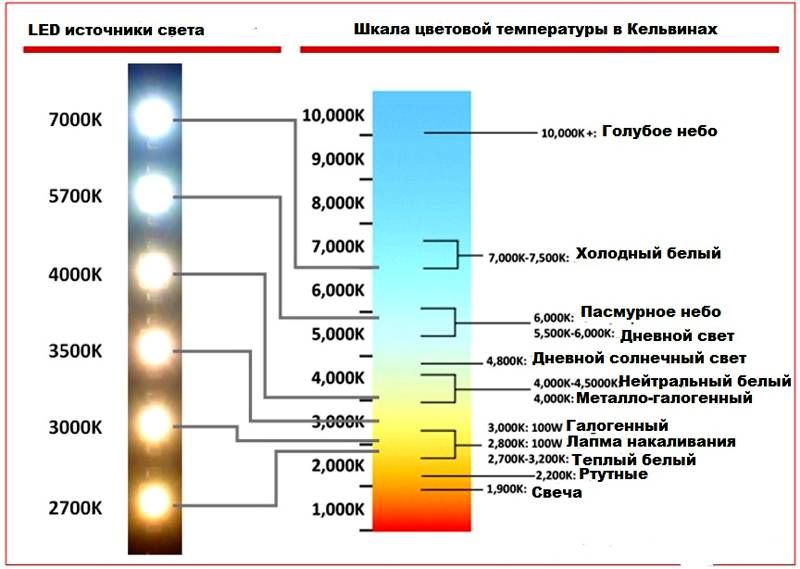
Related article:
Similar products can be selected for specific equipment or for the entire network. How to choose suitable model Numerous reviews on the Internet and a thorough study of the characteristics of the device, which we will consider in the article, will prompt.
Power table of energy-saving lamps and other light sources
| Lamp type | Electricity consumption, W | |||||
| incandescent | 25 | 40 | 60 | 80 | 100 | 150 |
| LED | 2,5-3 | 4-5 | 6-8 | 8-9 | 12-15 | 18-22 |
| Luminescent (energy saving) | 5-6 | 8-9,5 | 12-14 | 14-16 | 18-22 | 34,5-37 |
| Luminous flux, lm | 240-260 | 380-420 | 340-660 | 880-930 | 1250-1360 | 2080-2120 |
The ranges of figures in the tables are given taking into account data on products from different manufacturers. In some positions, errors in technical specifications energy saving lamps and other devices are associated with differences in measurement methods.
Related article:
How to choose the right device, what intensity is required, where to install the device, an overview of the original models - about this in the next material.
Comparison of energy-saving and LED lamps with obsolete appliances
Even taking into account possible inaccuracies in the above data, it is not difficult to draw the following conclusions:
Production technologies are constantly being improved. Energy companies' tariffs change frequently. That is why an accurate comparison of financial performance is not possible. You can take up-to-date data, analogues of a 75 W incandescent lamp. Savings over 8-10 years will be when using the following devices:
- LED - from 4500 to 6200 rubles;
- Energy saving - from 3900 to 5800 rubles.
The calculations were carried out taking into account the expected service life and the replacement of products that failed.
Are energy-saving lamps harmful to human health?
Concerns about dangers must be based on facts. Fluorescent lamps have been used for decades. Accumulated data not only laboratory tests, but also practical tests. It is not difficult to find reviews of ordinary users and solid expert opinions on the Internet. After studying the thematic information, the following important nuances can be noted:
- The radiation spectrum does not harm human health.
- Discomfort can create low-quality products created by dubious manufacturers. Defects appear in the form of extraneous sounds, an arbitrary change in brightness.
- Care must be taken when handling appliances to prevent chemical compounds from entering the atmosphere of the room. Modern models are made strong enough, so they do not break when dropped from a small height.
Note! Sometimes energy-saving lamps flash when off. This is not necessarily a sign of a problem. Check if a switch with built-in lighting is installed in the supply circuit. Through it, current can flow to the lamp start circuit.
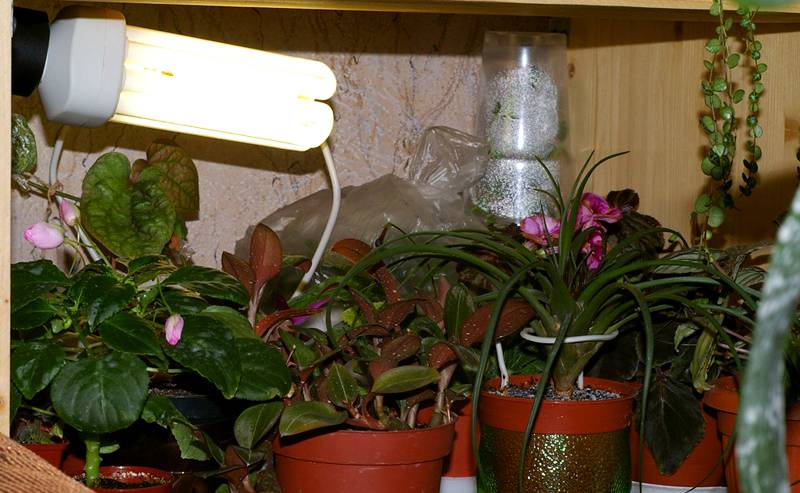
Overview of market offerings
| Picture | Brand/ Plinth | Power consumption, W | Color temperature, K | Luminous flux, lm | price, rub. |
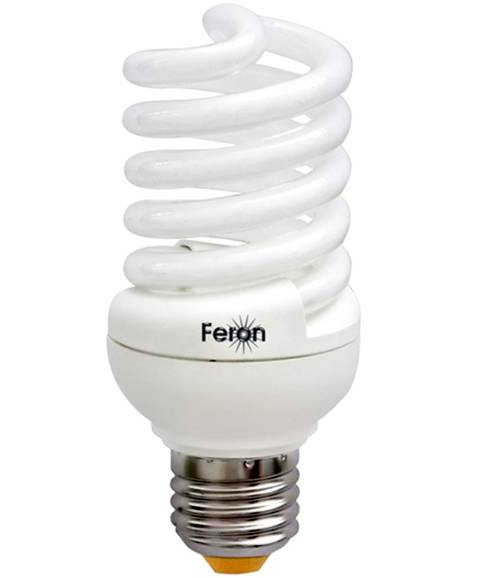 | Feron/E14 | - | 6400 | 540 | 31-34 |
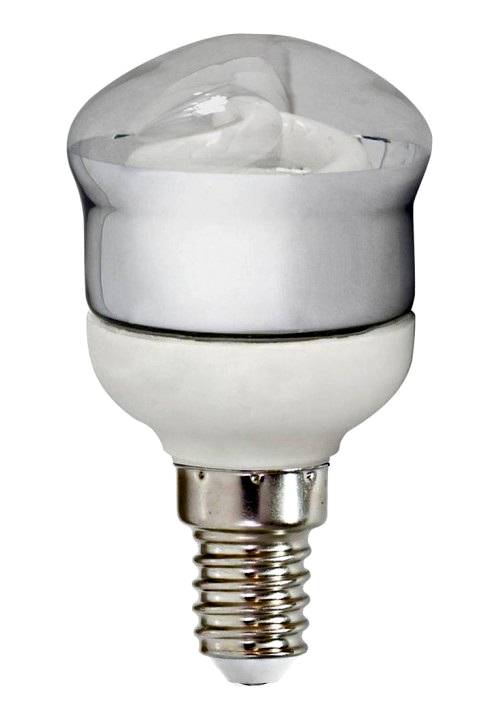 | Feron/ E14 4000 | - | 4000 | 540 | 19-20 |
 | Ecola/ GU5.3 | - | 6400 | - | 34-36 |
 | Elektrostandard/ GU5.3 | 11 | 2700 | - | 33-35 |
 | Osram/G13 | 18 | - | 1050 | 38-39 |
 | Uniel/ GU5.3 | 7 | 2800 | - | 50-70 |
 | Uniel/ E14 | 9 | - | 365 | 60-80 |
 | Navigator/G5 | 6 | 6400 | 360 | 65-73 |
 | SONNEN/ E27 | 25 | - | - | 60-85 |
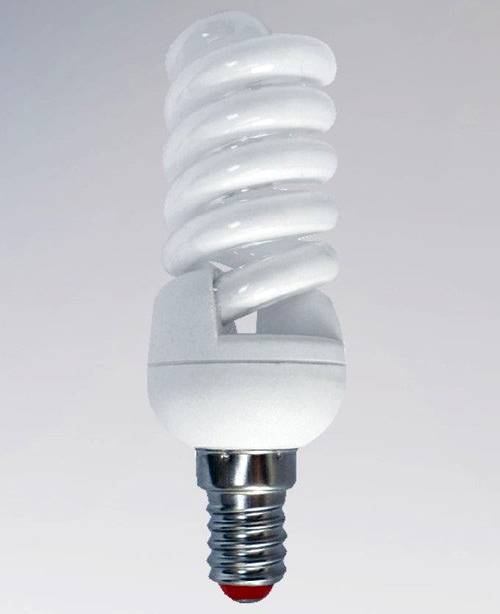 | Lightstar/E14 | 9 | 4000 | - | 63-92 |
 | Philips/G23 | 9 | 4000 | 600 | 135-158 |
 | Philips/E14 | 12 | 2700 | 740 | 160-250 |
Well-known brands are more expensive. But they are of the best quality. Their manufacturers indicate all the characteristics that potential users need to know. In addition to the information indicated in the table, you can find out the service life in hours, exact dimensions, and other data. However, new brands are actively gaining market share. They introduce novelties with good consumer parameters, offer reduced prices.
General conclusions
When studying energy-saving lamps, types and prices, other general characteristics, it is necessary to take into account their intended purpose and operating conditions.

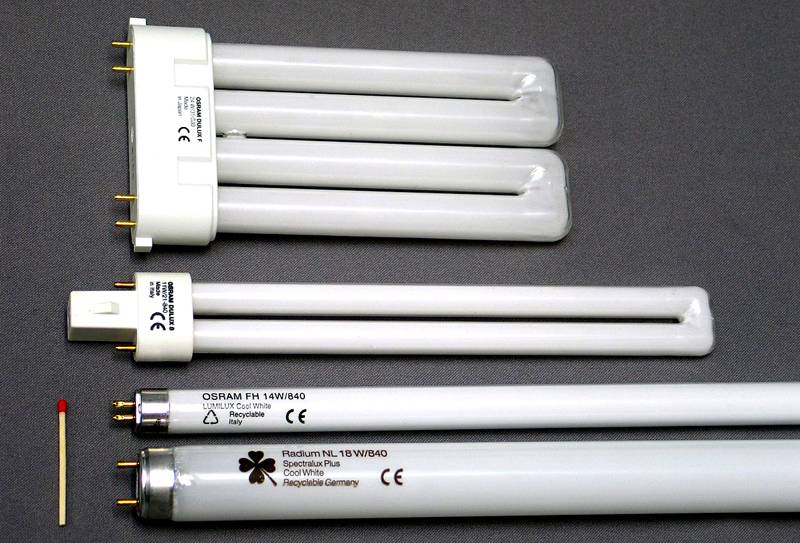


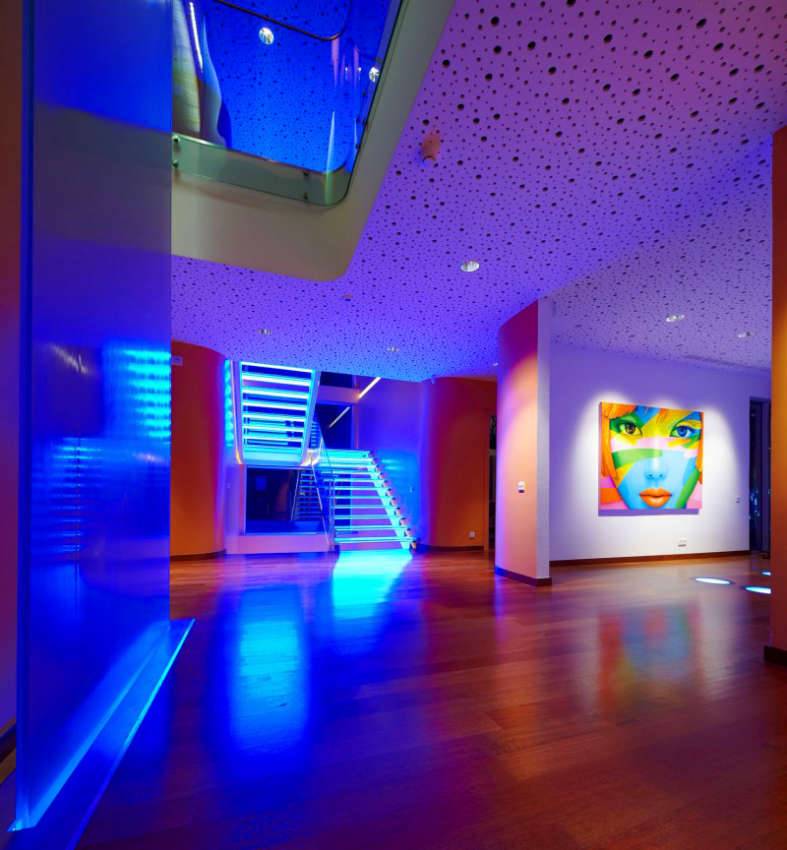

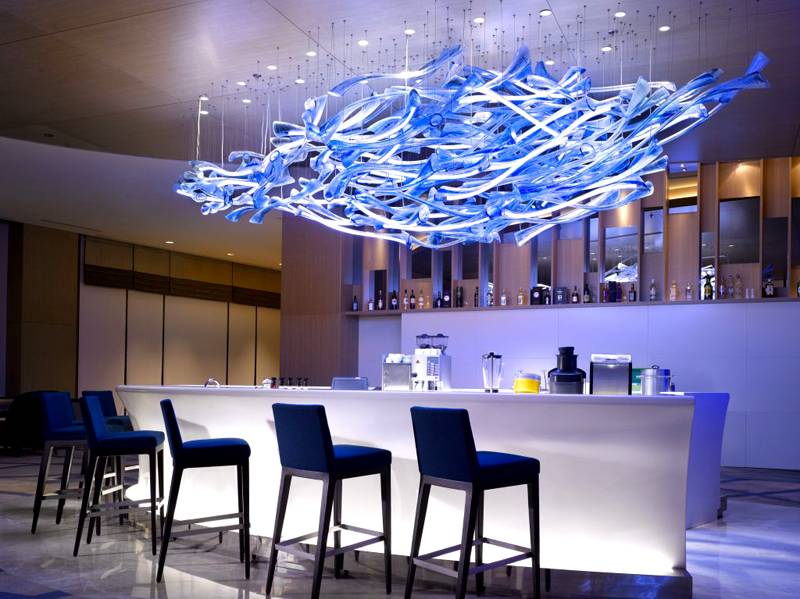

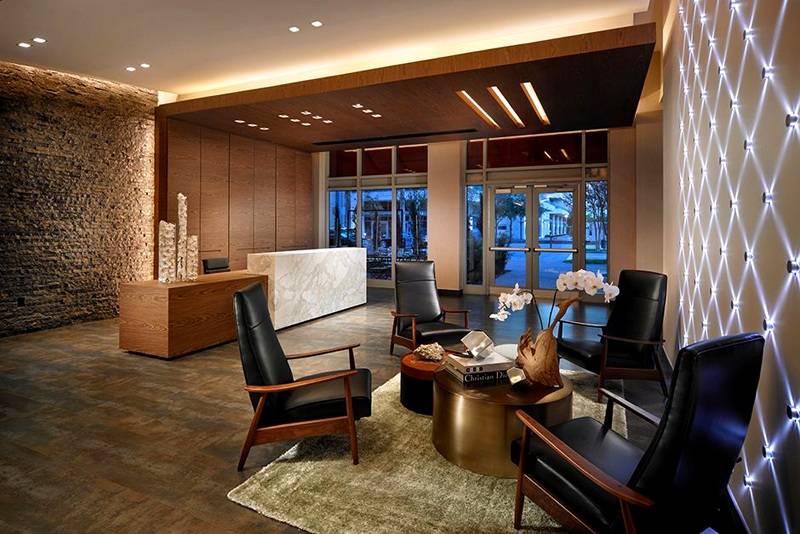
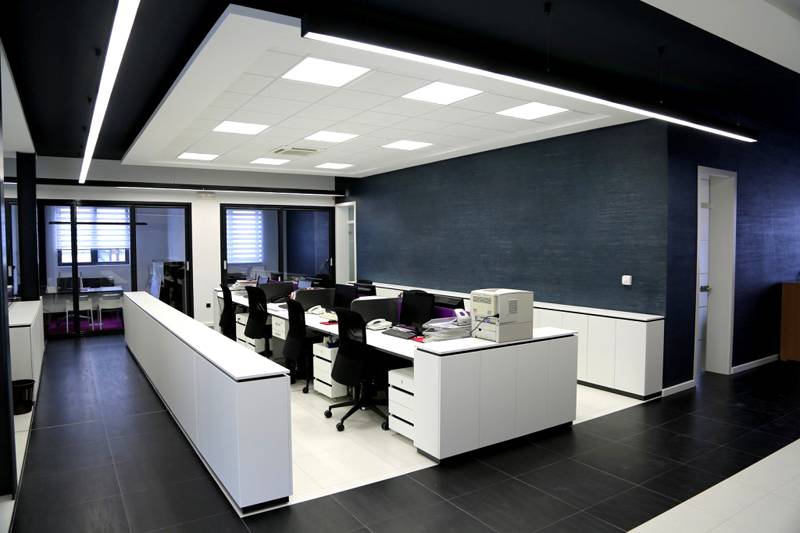
In a comprehensive assessment of the technical parameters of the lamps, it is necessary to add the expected service life and manufacturer's warranties.
The growing popularity of energy-saving lamps today is explained quite simply. Compared to conventional light bulbs, their light output is 5-8 times higher and amounts to 50-100 lm/W. At the same time, they radiate much less heat. These indicators allow you to save about 80% of electricity.
Today they are used not only in residential premises, but also for other purposes - on signal towers, in car headlights, in landscape design etc.
Energy saving lamps are lighting, working on a phosphor or on light-emitting diodes. They do not have a voltage filament, unlike incandescent lamps. What these 2 types of illuminators have in common is the presence of a base, due to which the same cartridges are used for their use as for ordinary light bulbs.
The main components of this device- ballast electronic device and a flask.
These 2 components divide energy-saving lamps into 2 types:
- luminescent;
- LED;
Fluorescent lamps

Among this variety of energy-saving devices, the main ones are linear and compact lamps.
Linear lamps can be called the progenitors of modern energy-saving lamps. The history of their appearance dates back to the 30s of the last century. They are in the form of a tube. At its ends there are glass legs on which the electrodes are fixed. Its constituent components are phosphor, mercury and an inert gas.
This device may also have an annular or U-shape. Its power depends on the size of the tube - its diameter and length. Most often, such illuminators are used in industrial and office premises.
compact light bulbs- the most common type of fluorescent devices. They are used both in production and in everyday life.
They are classified according to the following parameters:
- Plinth type which affects the scope. For example, the E27 base is designed for the most common cartridges. A higher numerical value in this case indicates a large cartridge size. The smaller this value, the smaller cartridge size is required for use. Lamps G23, G53 are used in wall and spotlights.
- The emission color is presented in the following range:
- warm white, emitting a soft yellow light;
- neutral white, having a slightly larger temperature range;
- cold white, the glow of which has a bluish tint;
- daytime, unlike the previous ones, is sharper, used in street lighting or in any large non-residential premises;
- The diameter of the flask is presented in four options:
- 12mm;
- 17mm;
- The form can also be divided into several varieties:
- U-shaped - stem type, having from one to six tubes. The number of tubes is indicated before the letter designation (1U, 2U, etc.);
- S - spiral lamp;
- R - reflex, next to it is indicated the digital value of the diameter of the flask (R63);
- C - cap "Candle" for protection; In addition, the second letter in the marking may indicate some design features: M - small size (SM); F stands for special design(SF);
- Power indicated on the package. Often, manufacturers indicate next to the equivalent value of a conventional light bulb in watts. For example, 12W = 60W. This means that with the same luminous flux, the amount of electricity consumed by a compact fluorescent lamp is 5 times less than that of a conventional one.
All these features indicate both the advantages of this type of device and its disadvantages.
Advantages:
- Energy saving with the same light output as incandescent lamps.
- Working period from 3000 to 15000 hours, depending on the quality of the manufacturer. This is undoubtedly a plus when installing the device in a hard-to-reach place.
- Thermal output slightly lower than conventional light bulbs. This allows you to safely use more powerful lamps in sconces, wall lamps.
- Uniformity light radiation.
- Thanks to different range color radiation, it is possible to give the lighting some originality.
Flaws:
- Frequent turning on and off shortens the service life.
- When the voltage changes in the network, the lamp may flash, and with a pulsed increase in voltage, it may fail.
- At elevated temperature, light emission is noticeably reduced, and at low temperatures (-15 degrees or more), the performance of the device is reduced to zero.
- To achieve the required brightness, they require a warm-up phase that can last from 5 seconds to 5 minutes.
- One of the downsides the price is considered to be almost 10 times higher than the cost of conventional light bulbs. But this disadvantage is compensated by a long service life and significant energy savings.
Given these features when choosing, you must follow some rules:
- At the time of buying must be checked for functionality. In this case, it is necessary to wait for full ignition.
- Depending on whether, for which purposes it is purchased, the color range is selected. For example, for a utility room, cold white light would be more suitable. In a residential area, warm light is more acceptable. At the same time, power is also taken into account.
- Besides, it is necessary to take into account the characteristics of the lamp itself.
LED lamp

This type of device consists of several elements:
- LEDs, which convert the current passing through them into light radiation.
- Pay.
- Diffuser, expanding the flow of light.
- Radiator designed to cool LEDs.
- Driver, which is an electronic circuit that converts the input voltage. The function of the driver also includes setting the required frequency for the voltage, which ensures a certain brightness.
- Ventilation holes provide air circulation in the device and heat outflow from the driver.
- plinth for connection to the mains.
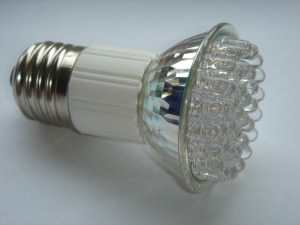
edison base
Differon several parameters:
- Plinth type:
- Flask (T), which are tube lamps. They have a swivel base in different sizes, the type of which is indicated by a numerical value (T5, T12, etc.).
- The Edison base (E) is connected to the power source using a thread like a conventional incandescent light bulb. The marking indicates the numerical value of the connection diameter.
- The pin base is equipped with mounting plugs, with which it is connected to the cartridge. Small letters in the marking indicate the number of pins, and the numbers indicate the diameter of the circle.
- According to the design of the housing and the quality of the emitted light, these devices are divided into:
- Led lamps general purpose. They are closest to diffused daylight.
- Led lamps of directional light, find their application mainly for backlighting.
- Linear, have a swivel base and are an elongated tube. They are mainly used in offices.
- By scope:
- Led lamps for the main lighting of residential and office premises;
- LEDs used for lighting in the corresponding interior;
- light bulbs intended for lighting in landscape design or any architectural element;
- industrial spotlights;
- Street lights;
- explosion-proof;
Unlike conventional light bulbs, as well as fluorescent energy-saving devices, LEDs have much greater advantages:
- Their service life reaches 45,000 hours.
- In their design There are no heating elements, which ensures their fire safety.
- Small sizes.
- Various options color range.
- There is no warm-up phase, the maximum glow occurs immediately after switching on.
- Electricity consumption is 8 times lower than incandescent bulbs and 3 times less than that of fluorescent devices with the same luminous flux.
- Environmental friendliness are completely safe during operation, as they do not contain any harmful components.
- Temperature drop to a minus mark, does not affect their work in any way.
The only downside to LEDs is their cost. It is much higher than that of all other energy-saving lamps. But taking into account the amount of electricity saved, the service life of these devices, this minus is fully compensated.
Selection rules and cost
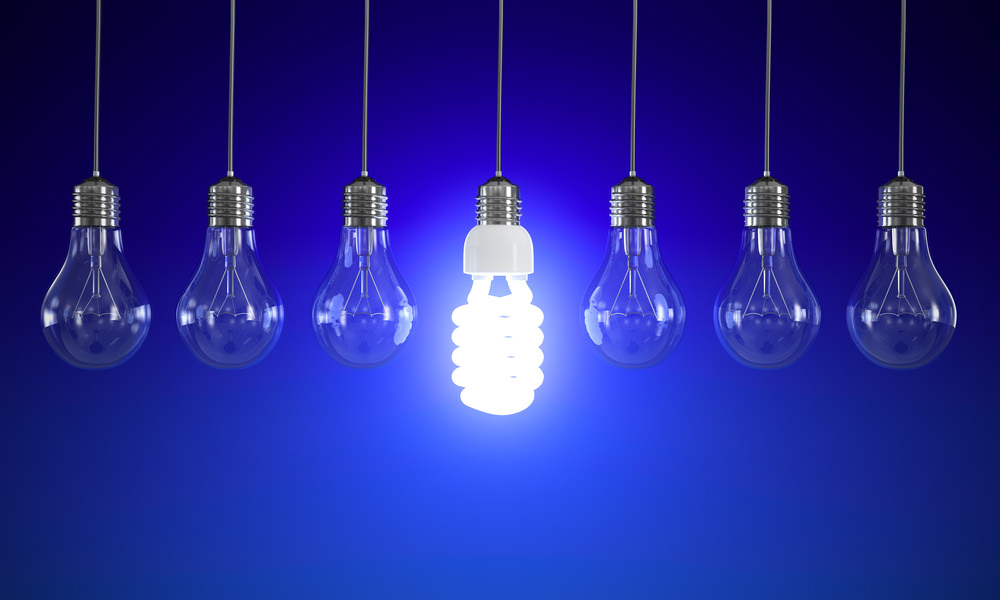
At the time of buying LED lamps it is necessary to focus, first of all, on the level of brightness, correlating it with power. For example, a lamp of 12-20 W has a brightness value of 1500 lm.
The color temperature indicated on the packaging provides the color of the glow. The higher this value, the whiter the light will turn to blue.
For the main lighting, a diffuser is required, in the case of spotlight this element is not needed.
The color rendering index must be at least 90%.
The cost is affected by the quality of the device, which to some extent depends on the manufacturer. Yes, Chinese and Russian products somewhat cheaper than imported analogues, although in general they are not inferior in quality.
The cost of fluorescent lamps ranges from 40 to 250 rubles.
LED light bulbs have a price of 100 rubles or more, depending on the design, power.
The rather high cost can, of course, serve as an obstacle to the acquisition of this product. But if you take into account all their characteristics, the main of which are efficiency and durability, the problem disappears.
Blitz tips:
- Before than screw energy saving light bulb, you need to turn off the power.
- When screwing, you need to hold the device by the body.
- If a Fluorescent Lamp crashed, it is necessary to collect the remains in a container, this must be done very quickly. The container must be tightly sealed. Then treat the surface with potassium permanganate. The room needs to be ventilated.
- Besides, this kind of devices in without fail subject to recycling.
- At the time of buying You need to pay attention to the manufacturer's warranty.
Until recently, energy-saving devices were not widely used in a room, as they were made in the form of tubes of different lengths. It was difficult for a simple user to install or change such models, compared to a conventional incandescent lamp. To date, this advanced luminescent device light fixture. Let us consider in detail what energy-saving lamps are (the types and price will help you figure out the choice for your room).
Models are found in 2 types:
- LED.
- Luminescent.
If we talk about light output, then LED designs she is much more.
Types of LED lamps and applications
LED (light-emitting diode) is a visually ordinary bulb with a semiconductor crystal. The range depends on the chemical semiconductor composition. AT modern technology, this is a new solution.

Classification:
- Plinth type.
- Application area.
- The type of LED used.
Consider LED models by application.
street lighting
Widely used in lighting large pools, public buildings, pedestrians and other public places.

Various decoration methods using smart RGB lighting fixtures are also widely used.
LED for home and office use
This type can completely replace all categories of previously used models: conventional incandescent lamps; fluorescent and halogen.

Visually, they are no different from their predecessors and have a similar base.
LED spotlights
This model was defined in a separate class. Until now, quartz light fluxes have been used in spotlights.
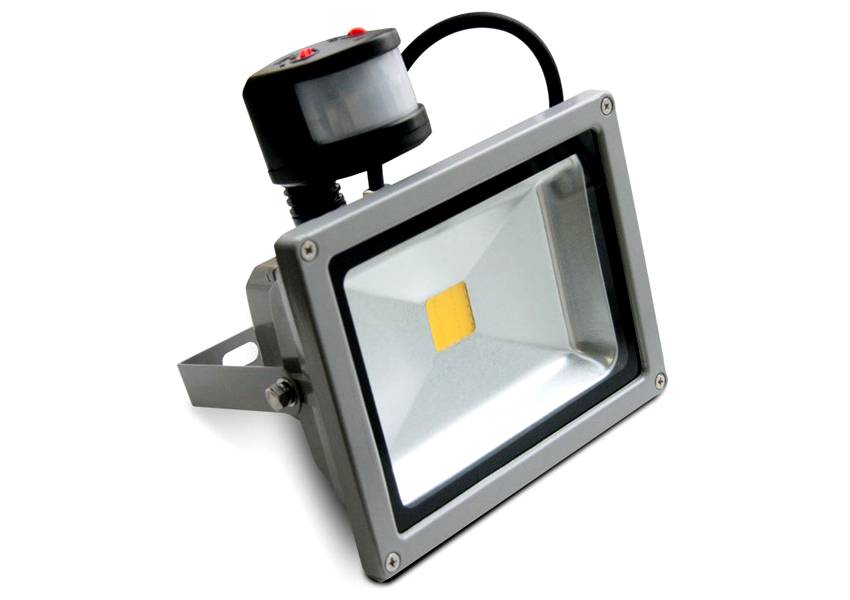
According to the technical characteristics and the difference in photometry, it is impossible to directly replace quartz lamps with LED models. Therefore, spotlights are designed specifically for the LED light source.
LED in industry
This direction is widely used in factories, warehouses and industries.

Distinctive features: ideal luminous flux; highest power and protection IP rating.
Models designed for growing plants
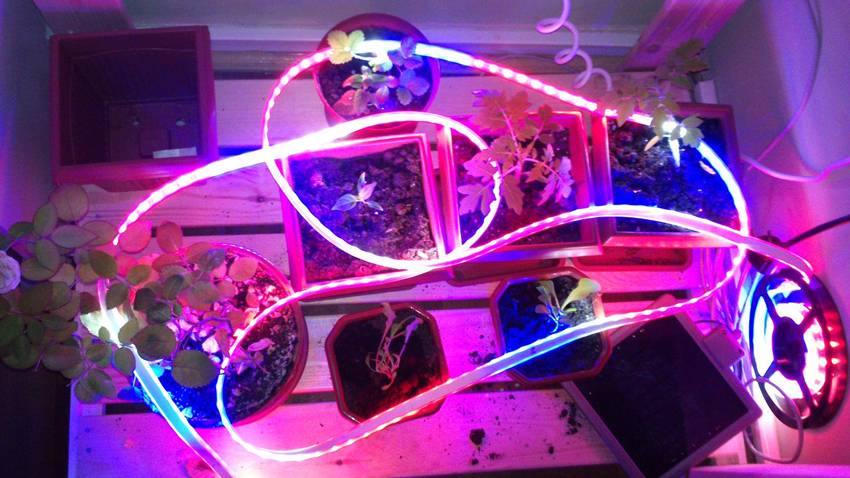
Note! In such models, the possibility of programming is sometimes used.
How are plinths classified?
The base is the part of the lighting fixture that is in contact with the power supply.
Types of socles of energy-saving lamps are divided into two groups:
- Screw, marked with the symbol "E".
- Pin "G".
- The price of one kW = 3 rubles.
- We will proceed from the calculation that the lamp burns 8 hours a day.
- We get 2920 hours per year.
Let us consider in more detail in the table how the plinths are classified:
| Types of plinth | Description |
|---|---|
 E27 Plain classical model with thread E27 Plain classical model with thread | Plinth suitable for chandeliers and lamps |
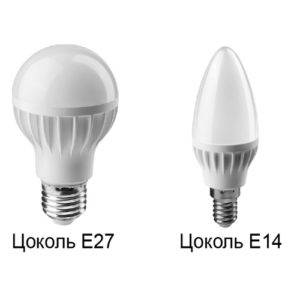 E14, this is E27, only with a smaller thread E14, this is E27, only with a smaller thread | Used in modern lighting fixtures. Models "candle", "minion" are produced with a plinth |
 GU5.3, similar to the base model of halogen GU5.3, similar to the base model of halogen | Such devices are used in LED lamps, and do not provide for design changes. |
 GU10 GU10 | The model can be found in the kitchen area, where the hood and lighting are used. |
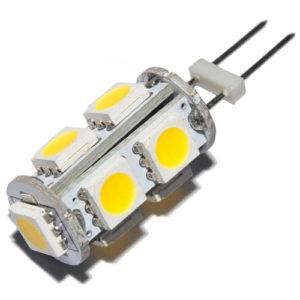 G4 base with two wires G4 base with two wires | Used in small light bulbs |
 G9 (male) G9 (male) | The base is the most convenient when installing or replacing the flask |
Energy-saving lamps and LED: comparison with predecessors
In order to get the full amount of information about each model, you need to visually familiarize yourself with the performance characteristics and make a comparison.
Note! In order for the comparison to occur with maximum accuracy, we determine the level of the luminous flux of the room (800 Lm).
It is approximately conventional model incandescent at 75 watts. Now let's give an example with 4 devices, with the same level of illumination.
Energy-saving lamp comparison table: specifications for incandescent, halogen and fluorescent appliances:
| Types / names | Degree of heating | Flux of light, lm | Power, W | Payment for the year / rub (20 devices) |
|---|---|---|---|---|
 Incandescent lighting fixture Incandescent lighting fixture | strong heat | 600-700 | 75 | 11000 |
| Medium heat | 600-700 | 15 | 2200 | |
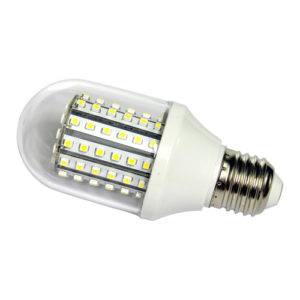 LED LED | Doesn't get hot or break | 800 | 10 | 1450 |
 Halogen Halogen | Gets hot, very brittle | 700 | 45 | 6600 |
Based on the data in the table, it can be concluded that LED lamps occupy the leading position.
Power consumption
It is clear from the data that for different types lamps, with the same illumination, the luminous efficiency is very different. As for the practical issue, the LED lighting device consumes almost 8 times less energy, which affects the costs for.
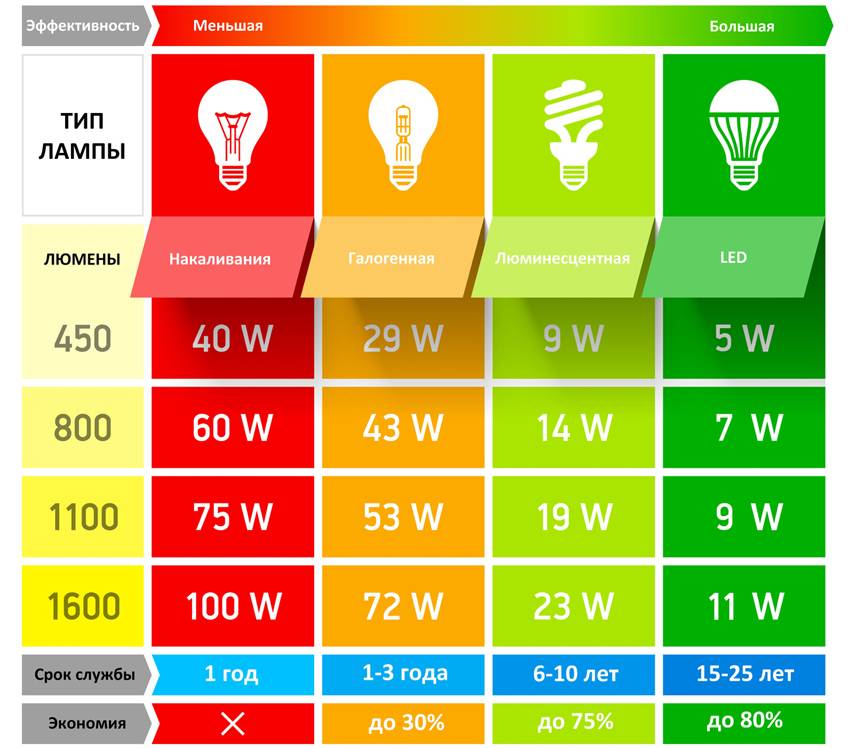
Note! A fluorescent lamp, for all its economy, is still less economical.
Saving
Let's do a little calculation:
Let's calculate the electricity for the year:
- Incandescent lamp: 2920x75 \u003d 219000 \u003d 219 kW per hour (219x3 \u003d 657 rubles).
- Fluorescent: 2920x15 \u003d 43800 \u003d 43.8 kW per hour (43.8x3 \u003d 131.4 rubles).
- LED: 2920x10 \u003d 29200 \u003d 29.2 kW per hour (29.2x3 \u003d 87.6 rubles).
- Halogen: 2920x45 \u003d 131400 \u003d 131.4 kW per hour (131.4x3 \u003d 394.2 rubles).
Based on the calculations, it can be seen that the LED model allows us to save a significant amount.
Ordinary and energy-saving lamp: power / table
The table shows the indicators without a protective bulb, which reduces the brightness by 20%.
| LED, W | Incandescent, W | Flux, lm |
|---|---|---|
| 3 | 25 | 250 |
| 5 | 40 | 400 |
| 8 | 60 | 650 |
| 14 | 100 | 1300 |
| 22 | 150 | 2100 |
Are energy-saving lamps harmful to human health (especially for children)?
Ecology is one of important indicators product. In terms of their data, halogen and incandescent lamps are environmentally friendly, their light spectrum is not harmful to human health. But considering the energy they consume, which is just wasted, they got a score of 4 on a five-point scale.

Fluorescent lighting products are rated 3 for several reasons:
- Energy-saving lamps blink when off, which makes the eyes very tired.
- The luminous flux is very weak and it is bad for eyesight.
- Mercury, if the lamp is damaged, can be harmful to health. Urgent disposal of the device will be required.
Note! LED lighting devices received a rating of five, as they have no disadvantage in terms of ecology and harm to the body.
Energy-saving lamps: types and price. Save or not?
In order to understand which model to choose for a particular room and save money, you need to look at the average cost, service life and calculate the total savings.

Now let's calculate the real savings of the LED lamp in relation to its predecessors. Its operating time is from 30 to 50 thousand hours, based on 8 hours a day.
Note! This adds up to 10 years of lamp life. During this period, we change 30 incandescent light sources and 3 fluorescent ones.
Calculate the amount for 10 years:
- LED - 500 rubles (1x500).
- Energy saving - 450 rubles (3x150).
- Lamp "Ilyich" - 900 rubles (30x3).
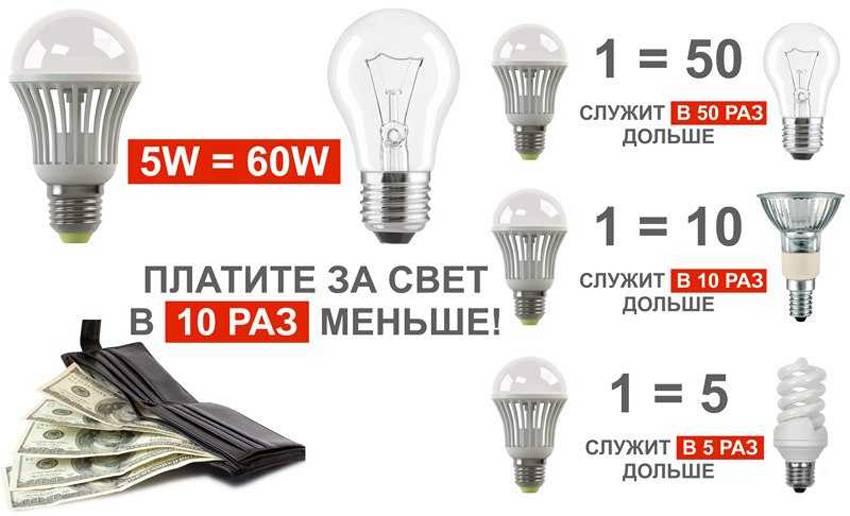
Then we add the amount of electricity consumed to the cost and multiply by 10 years:
- LED 938 (p).
- Luminescent 1501 (p).
- Incandescent 6156 (p).
Attention! If we compare an ordinary lamp with an LED light source, then the 2nd one will allow us to save at least up to 5,000 rubles.
We have dealt with the issue of cost and savings. Now the question arises how to choose a quality product in the presence of many manufacturers, prices, capacities and other details. Let's stop at the choice of the manufacturer.
The best brands of this year: top 3
The most widespread and high-quality brand is the company "Philips", which rightfully occupies the 1st place in the market. Distinctive characteristics are quality, environmental friendliness, the model has high technical characteristics and a long operating period.
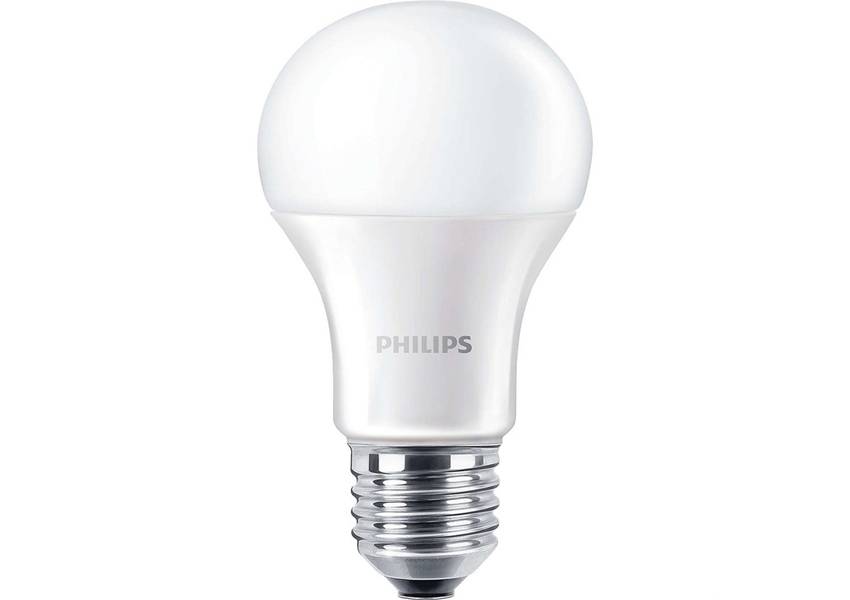
The second place in the top was taken by a domestic company Gauss. Weak heating of the flask, acceptable cost, great design.

In 3rd place is the German brand of the company Osram. For several years, the brand has gained momentum. The product quality is excellent, the product is reliable and economical.

Budget segment 2017 – the best manufacturers
Each consumer today is interested in the issue of price / quality, since not everyone is ready to spend a lot of money on an ordinary lamp.

We provide the top 3 2017 best manufacturers:
- The Russian manufacturer of the company entered the top three "Optogan" and competes with European and domestic brands.
- The second place rightfully belongs to the Chinese famous brand "Camelion".
- Firm NICHIA pleases its consumers with high-quality assembly, reasonable price and economy.
Any model from good manufacturer can be purchased at any specialized store, it is important to make a choice.
The transition from fluorescent light sources to LED is no longer so surprising to the consumer's imagination.

A simple calculation will help you see the effect of real savings:
- Simple lamps often burn out and need to be changed or bought frequently. LED models, almost eternal.
- It is profitable to buy a light source of the latest generation in those rooms where there are a lot of lamps and the light is on almost constantly.
- The LED device is environmentally friendly, does not require attention in use.
Of all these characteristics, LED lamps are the best and most economical.
Article
The emergence of different light sources on the market makes users spend more time analyzing the situation. To choose best option, it is necessary to check the compliance of products with operating conditions. Cost-effectiveness is of particular importance, and initial and future costs are included in the calculation. Particular attention is paid to energy-saving lamps, types and prices, application features. In order for the study to be complete, it is necessary to make a comparison with other products of a similar purpose.
Energy-saving lamps in the interior - comfort and rational use of resources
To draw the right conclusions, the relevant subject is studied thoroughly. In this case, you need to find out:
- The principle of operation of products.
- Specifications and significant differences between different modifications.
- Market offers.
- Features of use.
The same algorithm will be useful later for comparing energy-saving lamps, types and prices, with classic and latest light sources.
Principles of operation and basic definitions
Products of this type consist of the following parts:
- The power supply is connected to a standard 220V network. The output is pulsating high voltage.
- It raises the temperature of the working coils installed inside a sealed glass flask.
- Its surface is coated from the inside with a phosphor composition. Mercury vapor is enclosed in a glass envelope.
- When the lamp is turned on, an electrical discharge is formed in a gaseous conductive medium. Under its influence, mercury vapor generates radiation in the UV range.
- It has the necessary effect on the phosphor, which begins to glow in the part of the spectrum visible to the human eye. The parameters of these waves (length, intensity) depend on chemical composition mixtures.
From this description it is clear why there is a delay when such devices are connected to the network. If ordinary incandescent lamps begin to glow immediately, then it takes time to create a discharge in a gaseous medium and other processes. It should also be noted the need to use a special voltage converter.
For ordinary consumers, the following parameters are important:
- Low consumption of electrical energy with a sufficient level of luminous flux.
- Comfortable spectrum of radiation for the eyes.
- No long delays when turning on.
- Long service life.
- Resistant to repeated switching, voltage drops, vibrations and other external influences.
How energy-saving lamps are used: types and cost of operation
Previously, it was economically viable to create only the simplest shapes, straight tubes. The current level of technological development allows you to inexpensively create a variety of products.
These products are selected in accordance with the size of the lampshades and other size restrictions. Take into account the required light intensity. Special transformers and other voltage converters are not needed. Typical protective equipment (machines), switches are used.
Note! The exceptions are situations where smooth adjustment of light is necessary. To do this, you must purchase special lamp modifications that are compatible with dimmers. Manufacturers make corresponding marks in the accompanying documentation.
To calculate current costs, you can use the conditional tariff of 5 rubles. for 1 kWh. A high-quality fluorescent lamp from a well-known manufacturer is able to perform its functions with a minimum probability of failure of 6000 hours or more. When switched on daily for 8 hours, replacement will be required no earlier than after three years. In this intensive mode of use, a device with a power of 20 W will consume 58.4 kWh (292 rubles) per year.
Energy-saving lamps: are they harmful to human health?
Clarification is needed to rule out misinterpretations. This article discusses the parameters of modern compact fluorescent energy-saving lamps. They meet the requirements of sanitary and hygienic standards. The following are typical misconceptions and explanations given:
- Harmful ultraviolet. In fact, radiation in this part of the spectrum is necessary to maintain the physiology and well-being of a person in a good state. If 10 hours is in the zone of illumination by a lamp with a high level of about 1100 lm, then the radiation dose will be comparable to exposure to the sun from 45 to 60 minutes.
- A pulsating light source is really harmful. But such shortcomings are typical only for older models, with a remote.
- Similar arguments apply to prolonged ignition, flashing during operation. In new models of lamps created by well-known manufacturers, there are no such defects.
- To get "warm" lighting, it is necessary to choose sources that generate radiation with a thermal temperature of 2600 to 3200 K. "Cold" light (3200 to 6400 K) is used in offices and shopping centers.
Note! To avoid distortion of natural shades, you need to pay attention to the color rendering index. In high-quality light sources, this parameter is higher than the level of 78-82.
Table of energy-saving lamps of different power: current state of the market
| image ing | production parent/ Model | power power, W | Type of plinth | Light flow, lm | color coma tempe ratura, K | Term services, thousand hours | Price, rub. |
|---|---|---|---|---|---|---|---|
| Ultra/FS | 11 | E14 | 534 | 4200 | 10 | 68-73 | |
 | Ultra/HFS | 20 | E27 | 1250 | 2700 | 12 | 78-85 |
 | Electric Light/ E1 | 20 | E27 | 1150 | 4000 | 8 | 140-170 |
 | Supra/ SL-FSP | 12 | E14 | 720 | 2700 | 8 | 420-470 |
 | ECON/ FSP | 20 | E27 | 1100 | 4200 | 8 | 490-530 |
Comparison of energy saving and LED lamps
For the study, only these types of devices were selected as the most promising. Incandescent lamps use too much energy to generate heat. Halogen - not economical enough.
Types of LED lamps
These products are produced in different versions.
Related article:
LED technology is steadily strengthening its position in the lighting equipment market. How not to get confused in all the variety of options and choose the best lamps for your home? Let's figure it out.
What light sources are best
To compare the main technical parameters, the following data will be useful:
To compare the efficiency, you can use the technology of the previous calculation.
| Image | View lamps | power, Tue | Power consumption per year, kW | Costs for electro energy, rub. |
|---|---|---|---|---|
 | incandescent | 100 | 292 | 1460 |
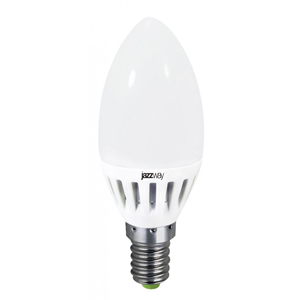 | LED | 13 | 37,96 | 188 |
 | fluorescent | 20 | 58,4 | 192 |
Even a detailed study of energy-saving lamps, types and prices does not allow us to draw unambiguous conclusions. So far, LED counterparts are more expensive, so years of operation without breakdowns will be needed for tangible savings. The manufacturing technology of luminescent devices has been better developed in practice, so their high reliability is ensured.
In order for the comparison to be objective, it is necessary to take into account the features of operation, real negative impacts. It will be useful to check the current market offers, prices and warranties of different manufacturers.
Choosing an energy-saving and LED lamp (video)
You may also be interested in:

 LED lamps for indoor lighting: advantages, features and varieties
LED lamps for indoor lighting: advantages, features and varieties



